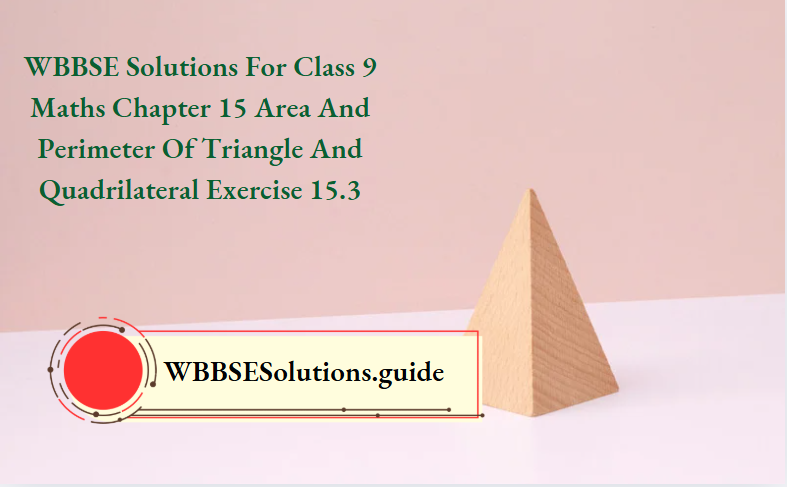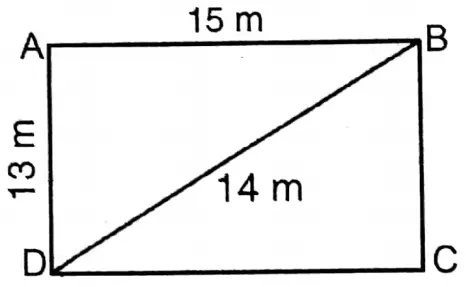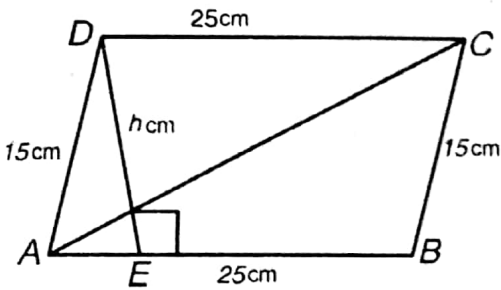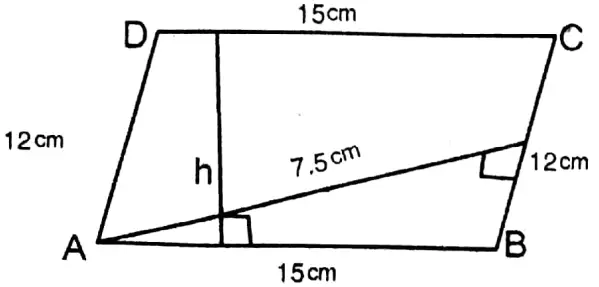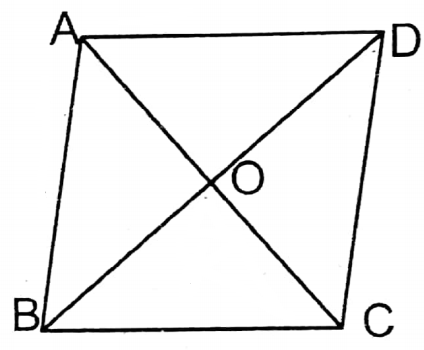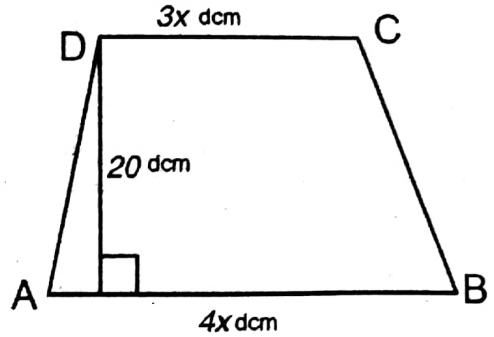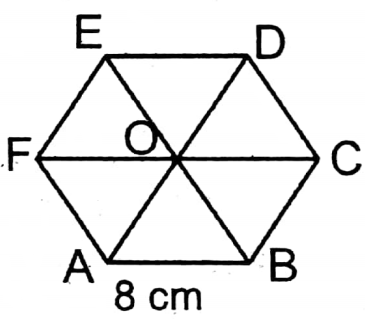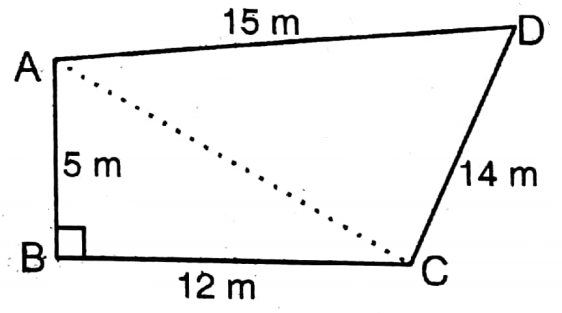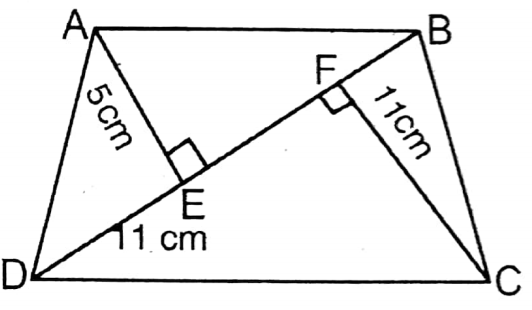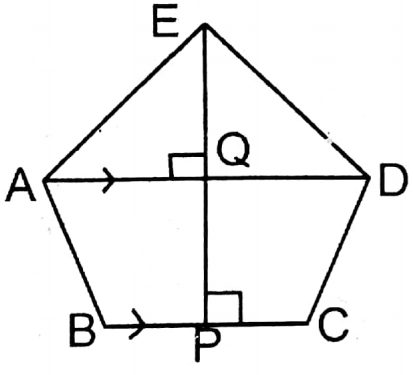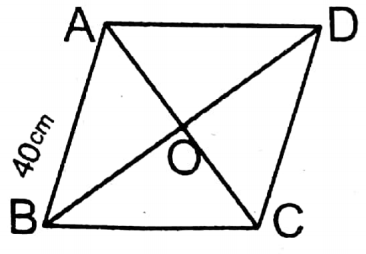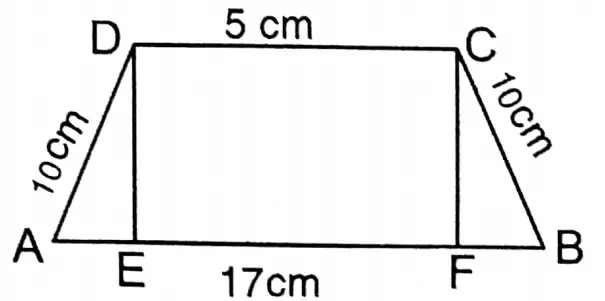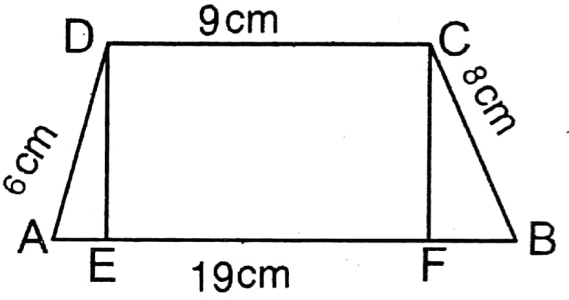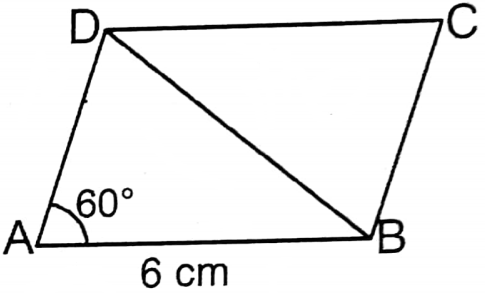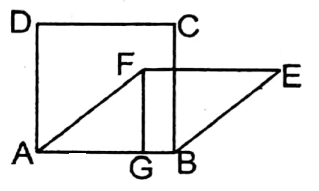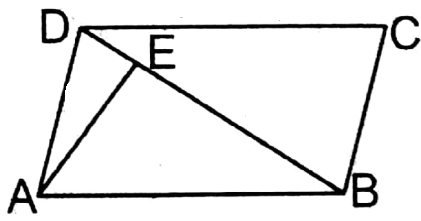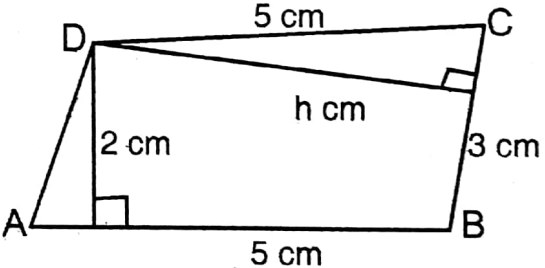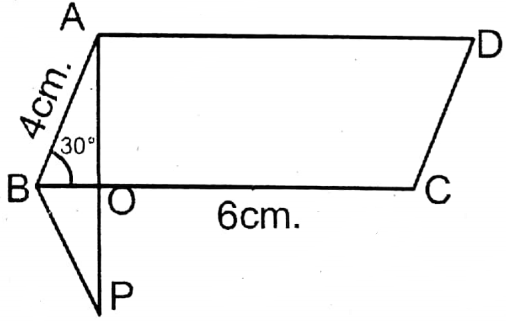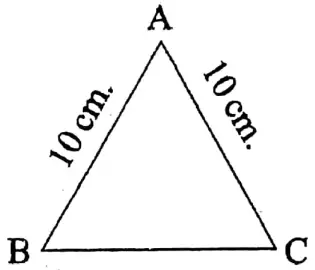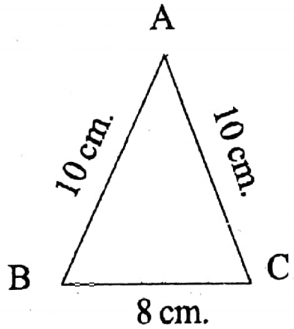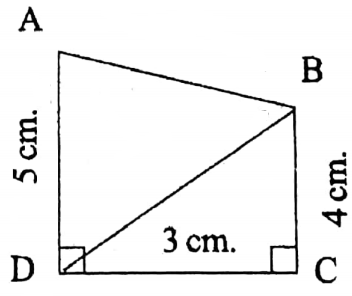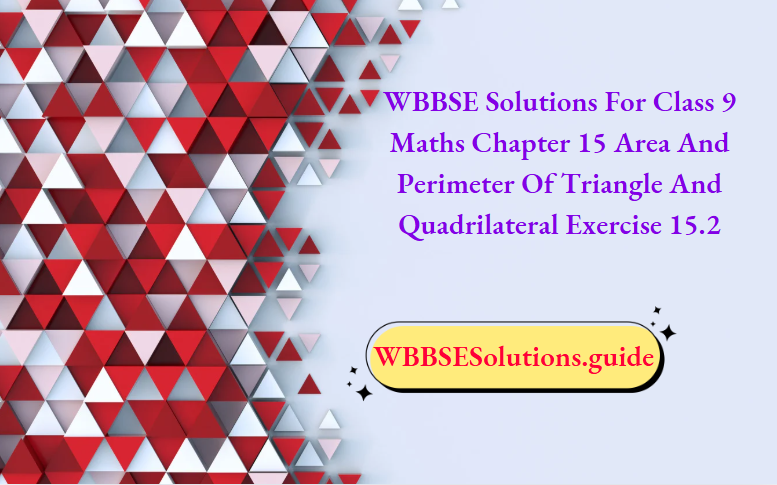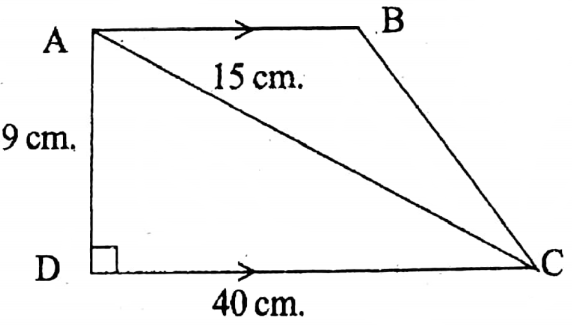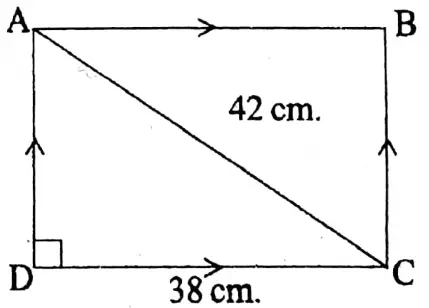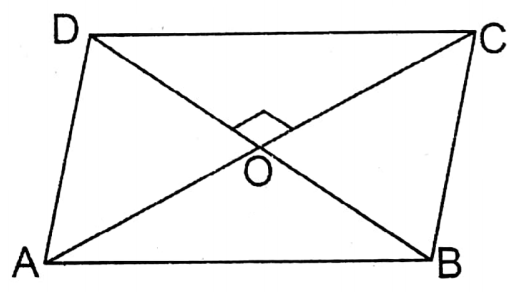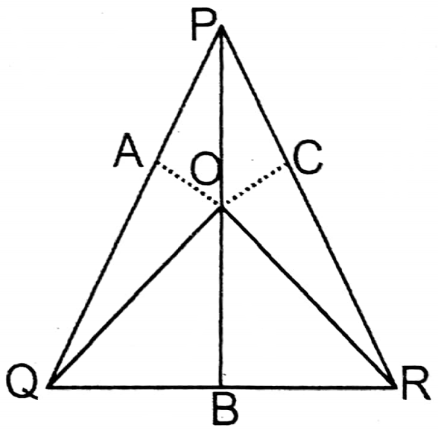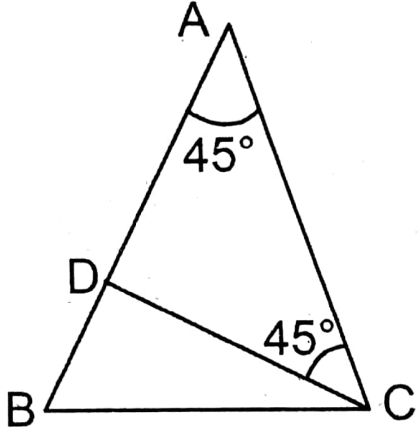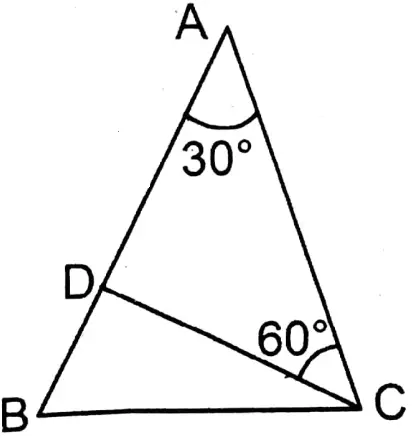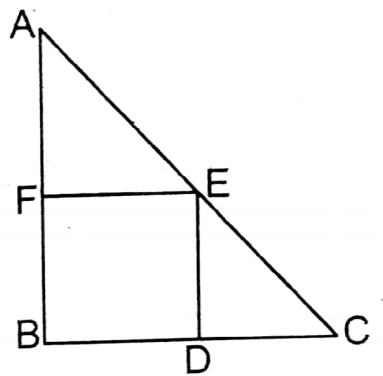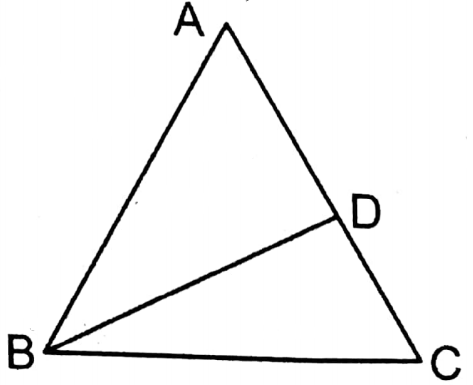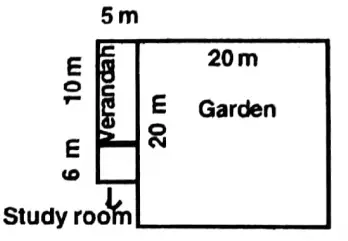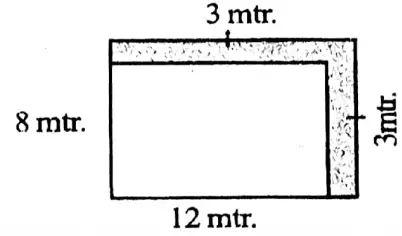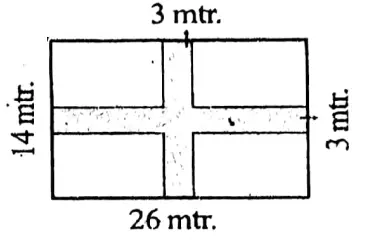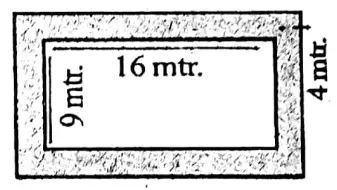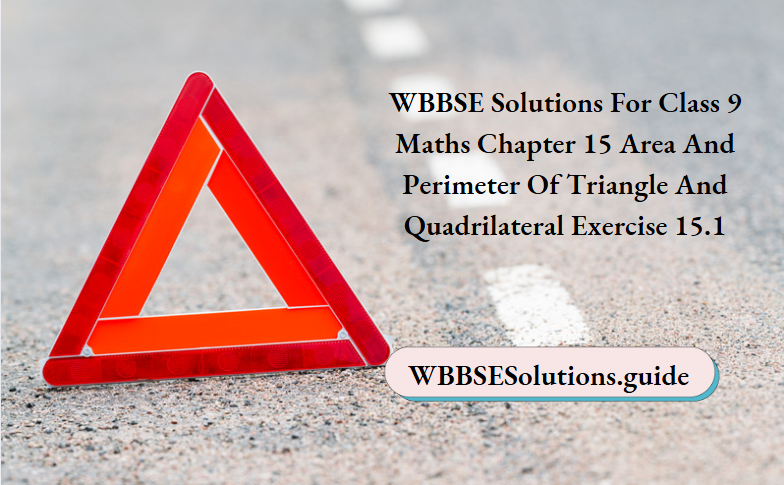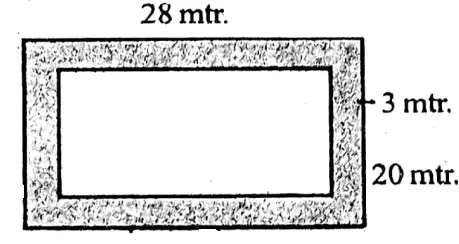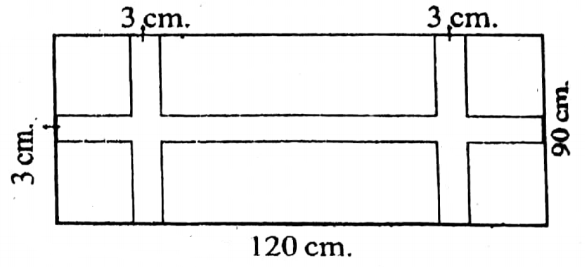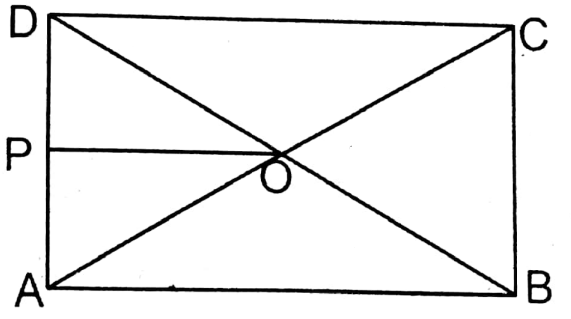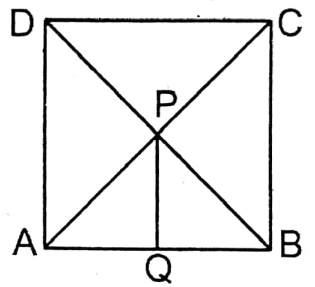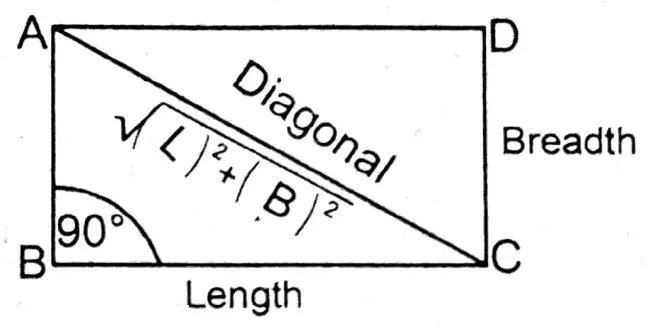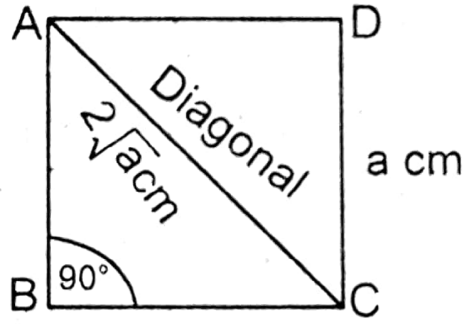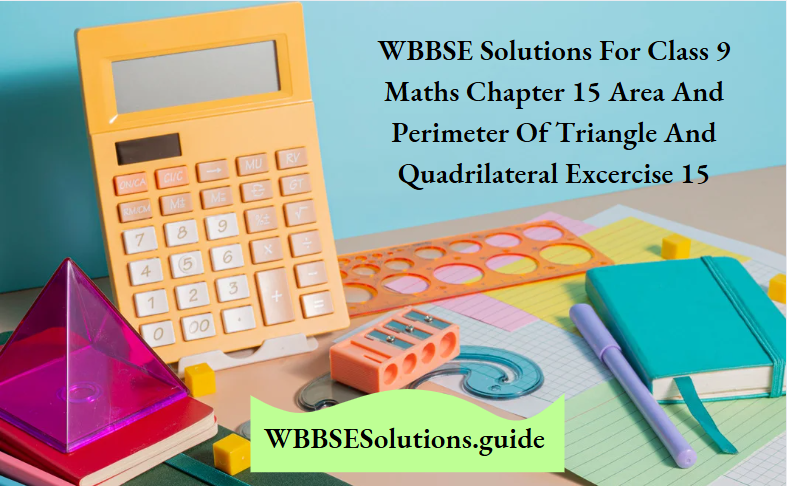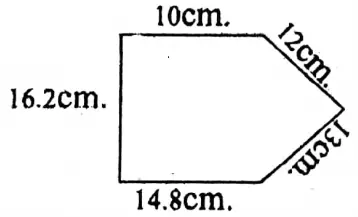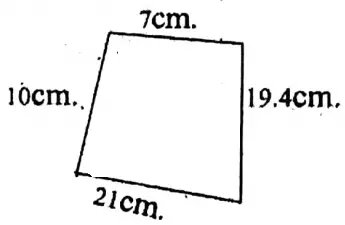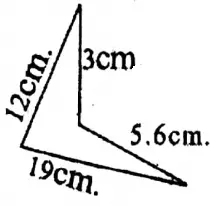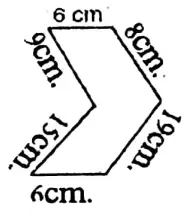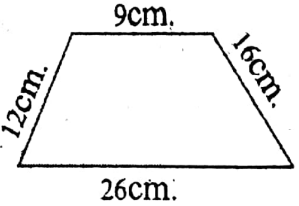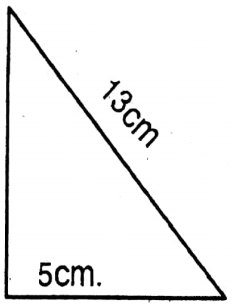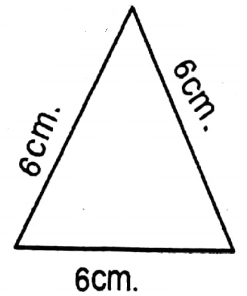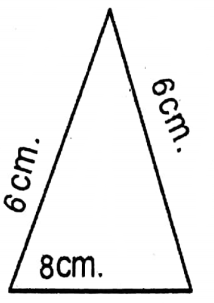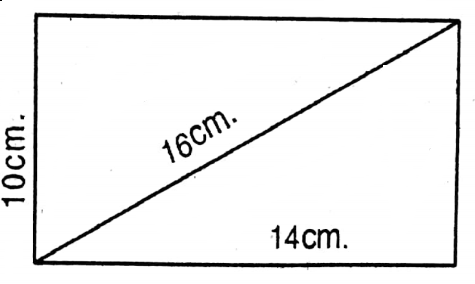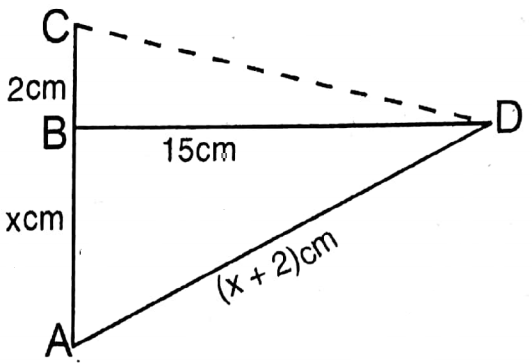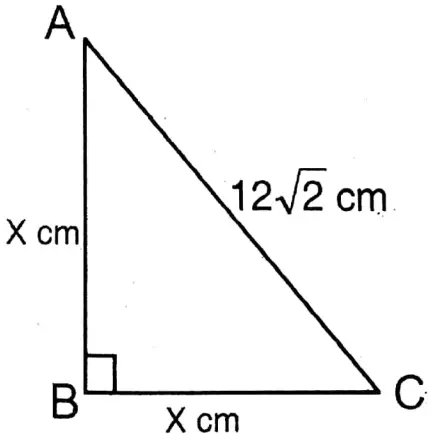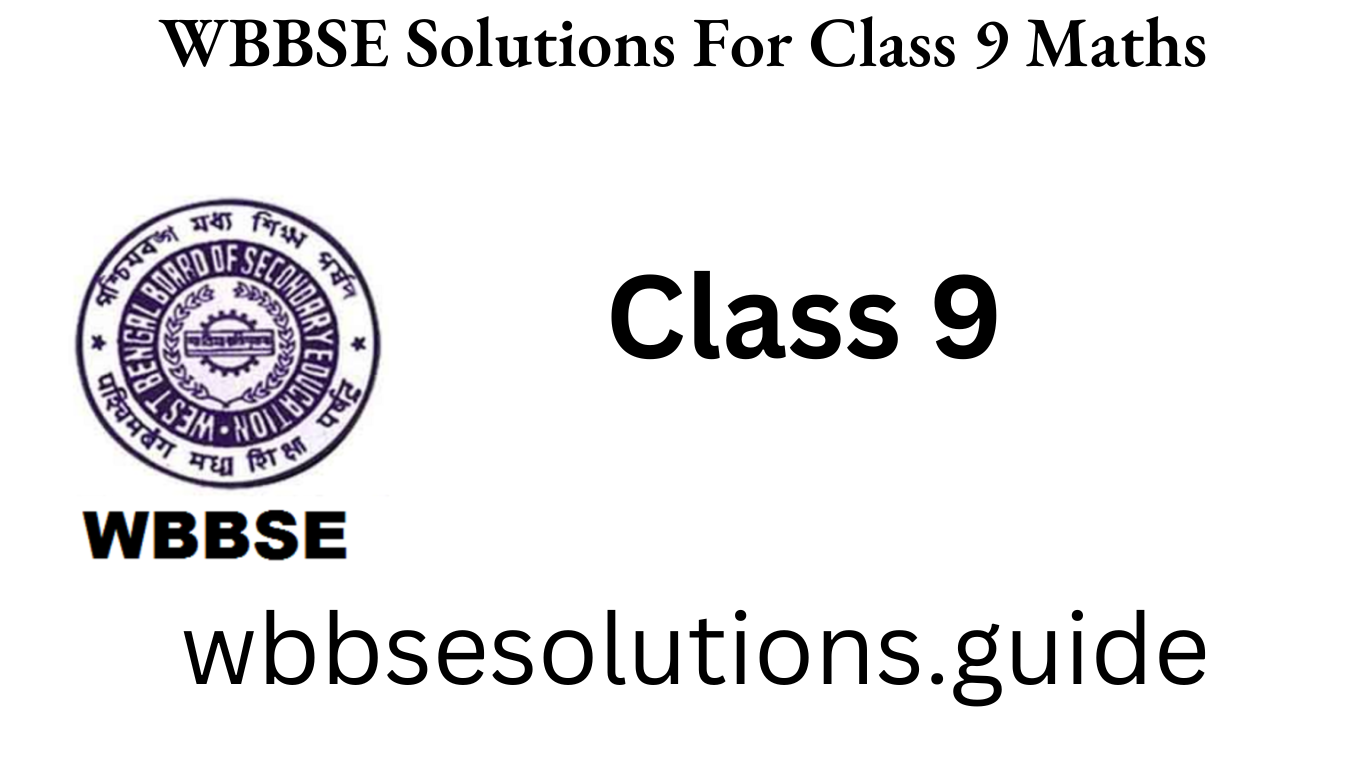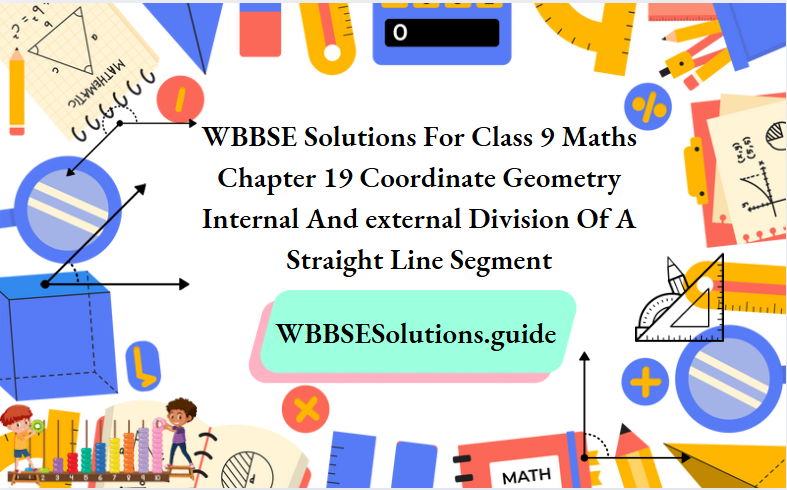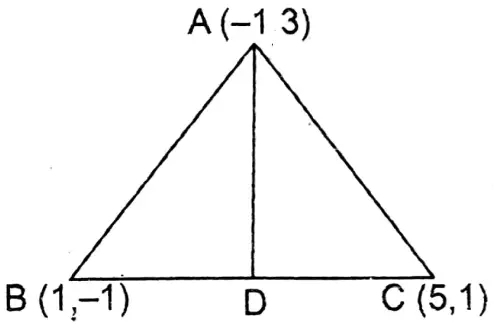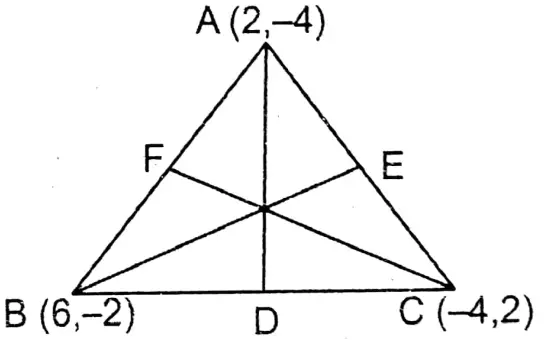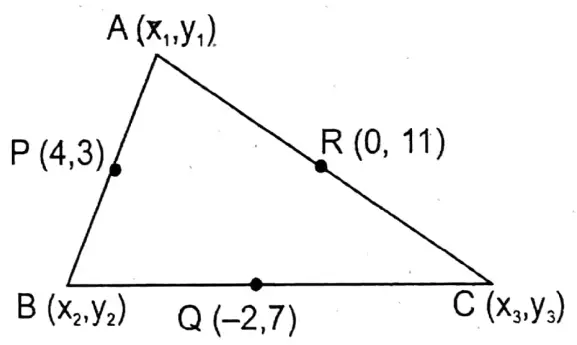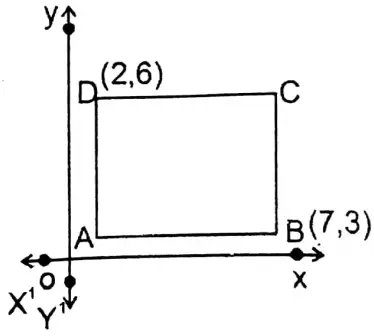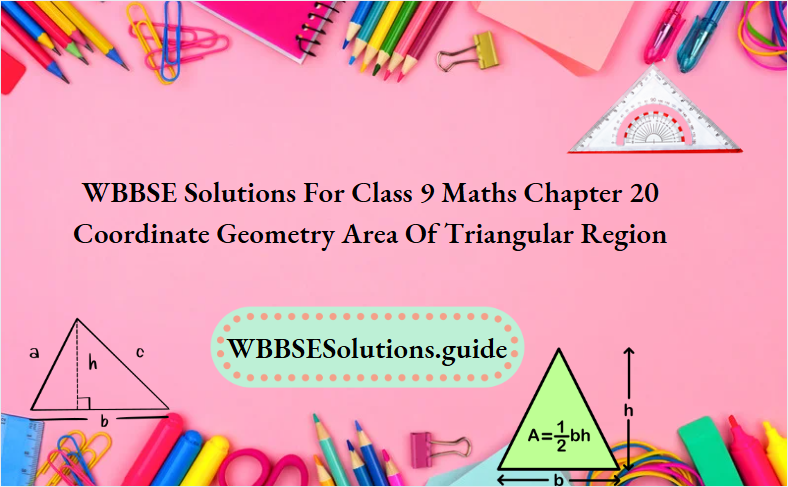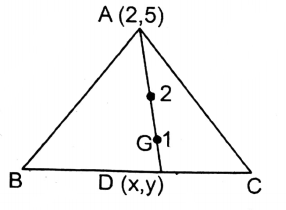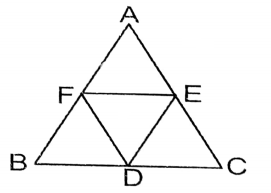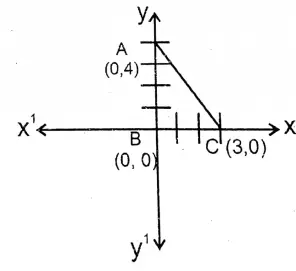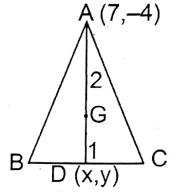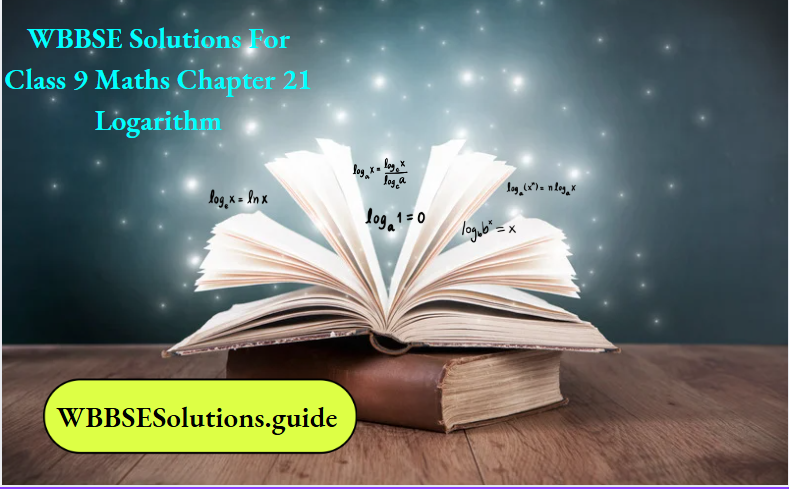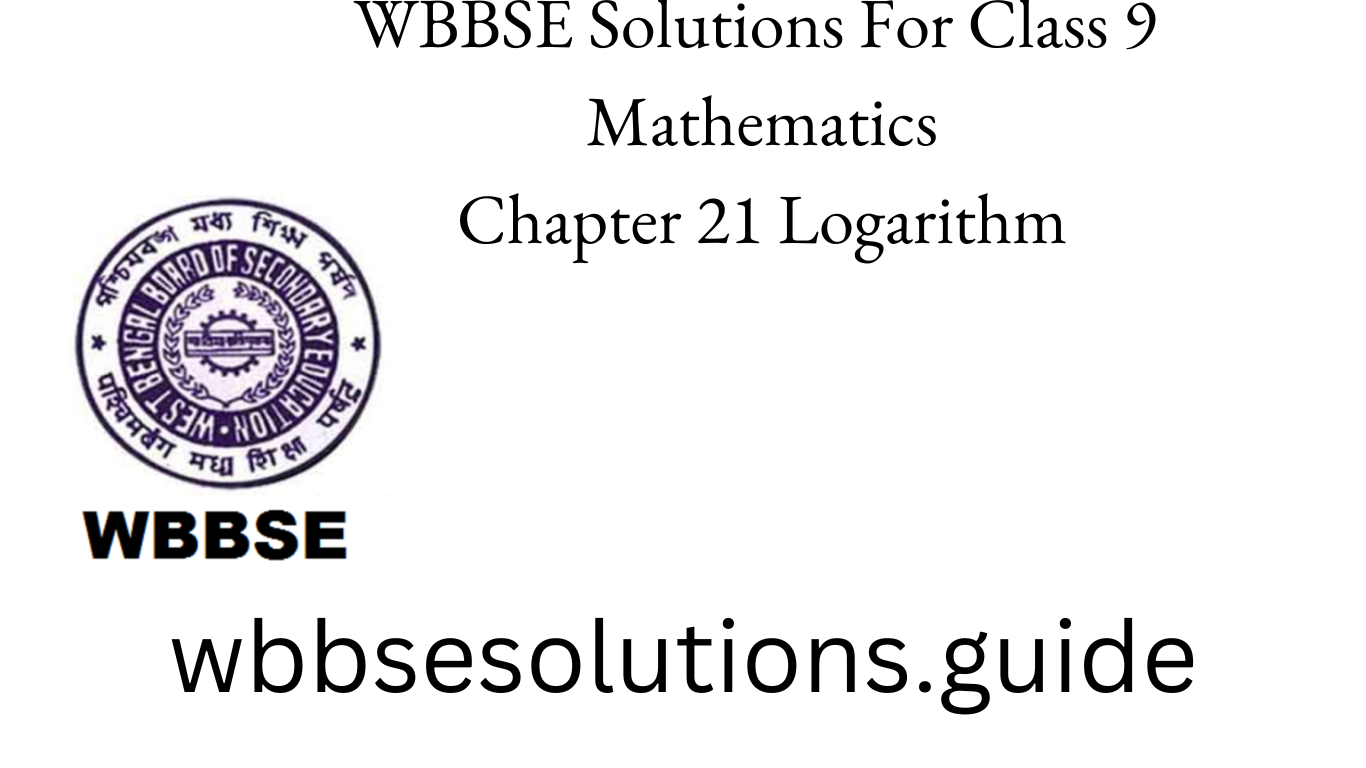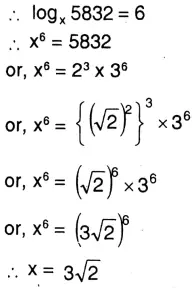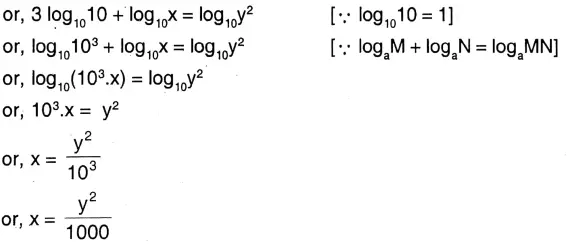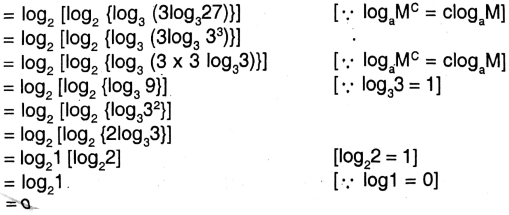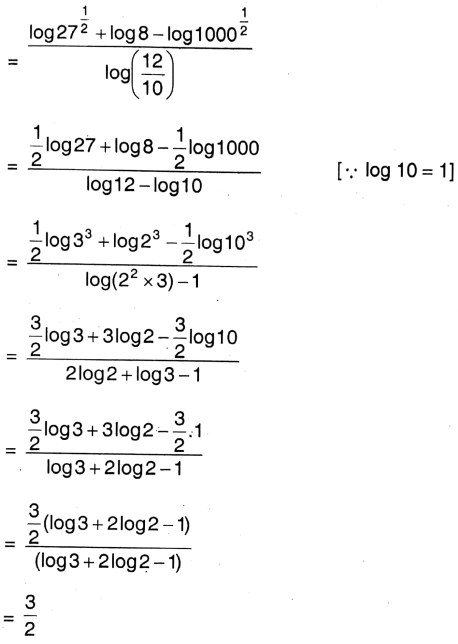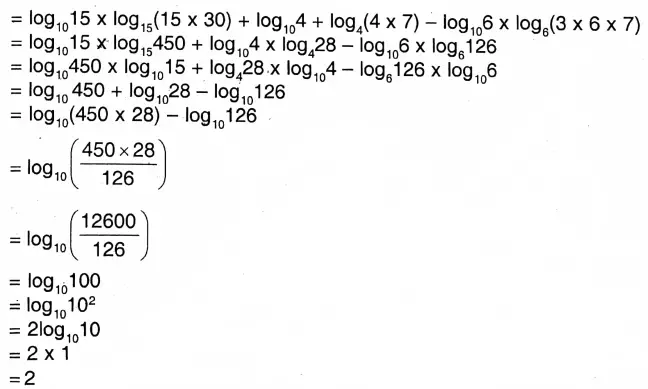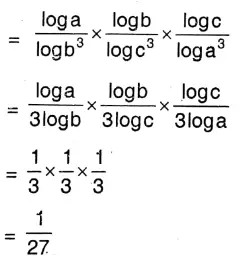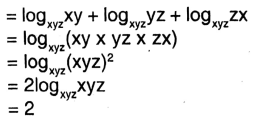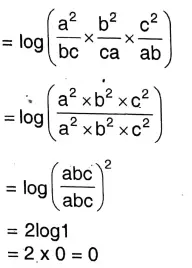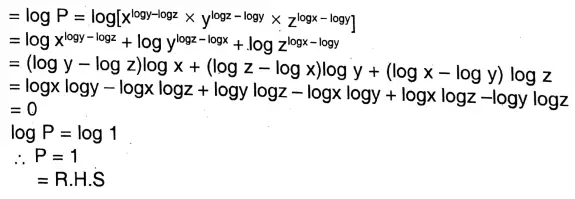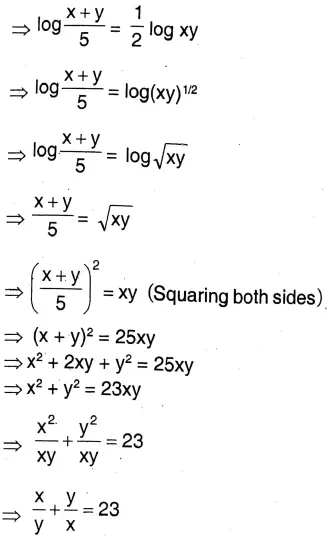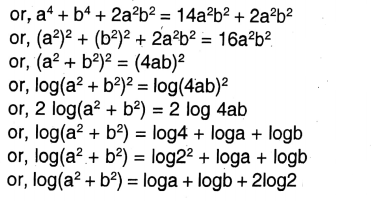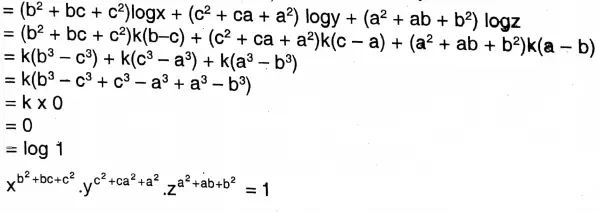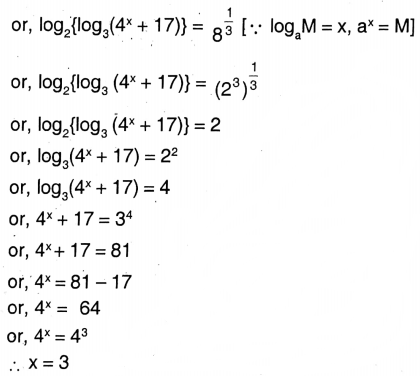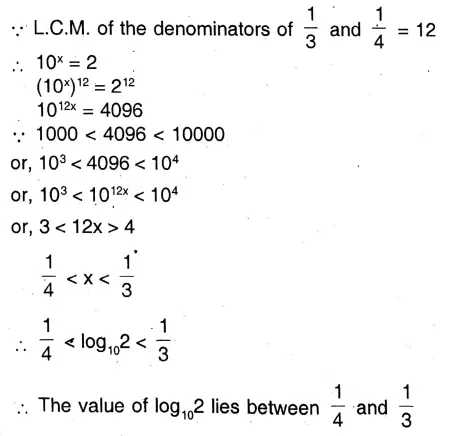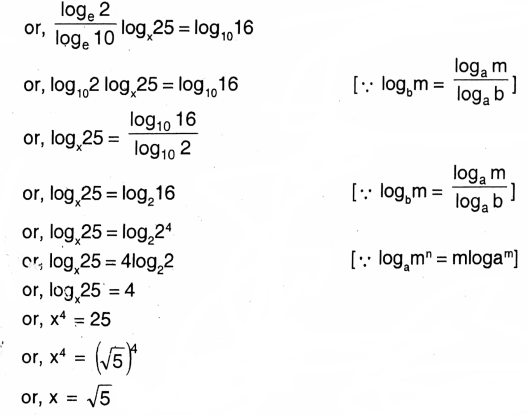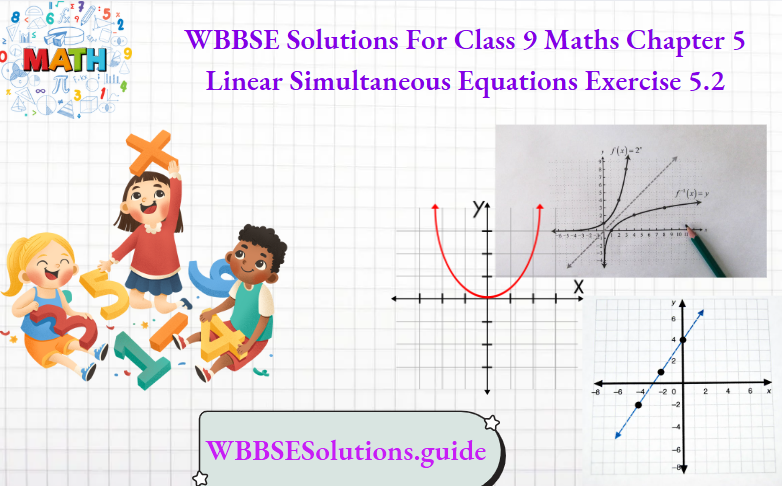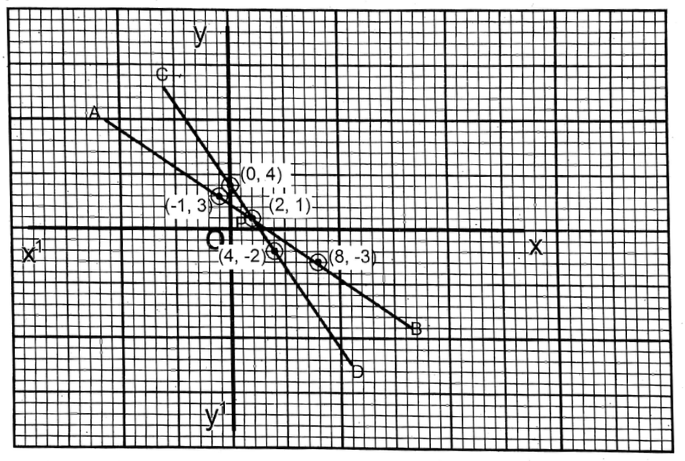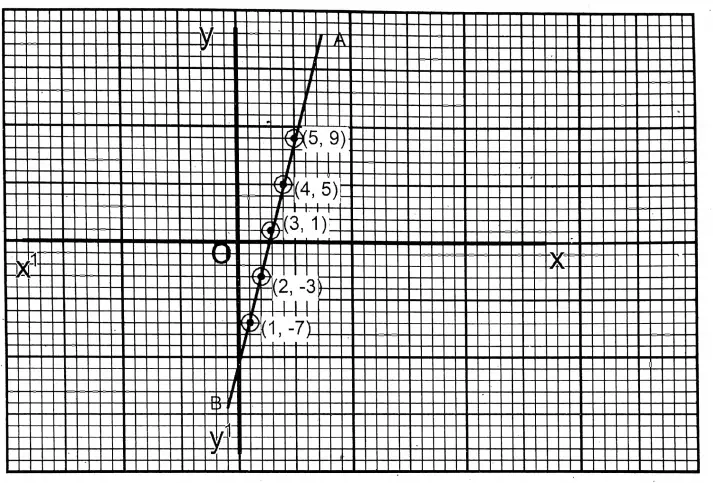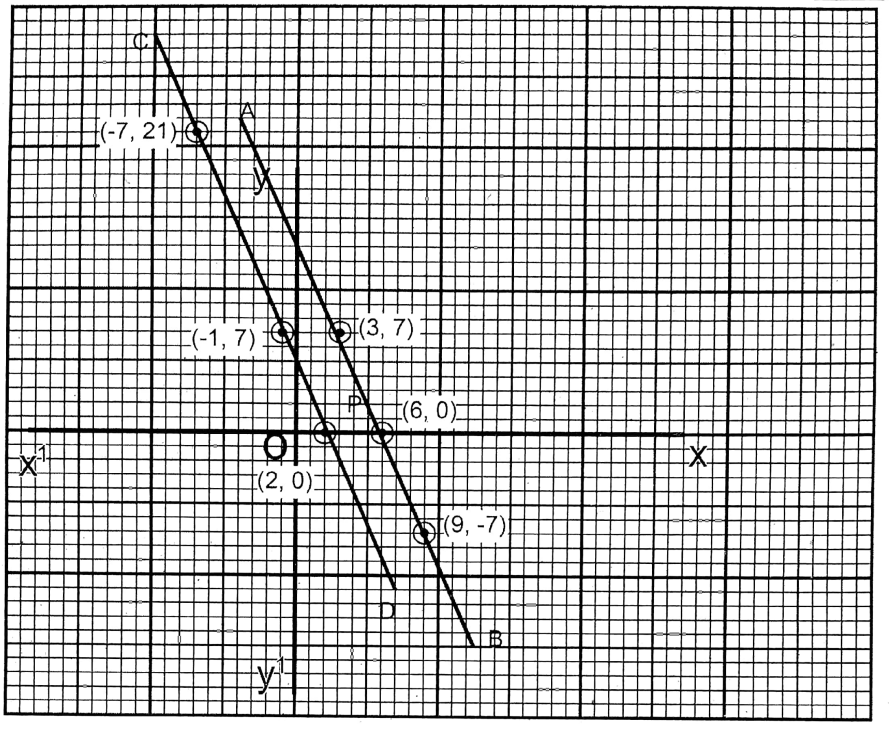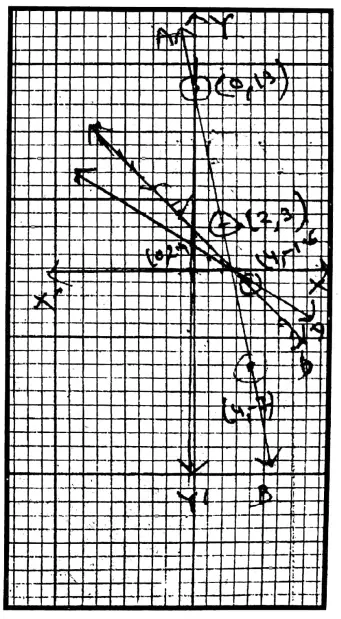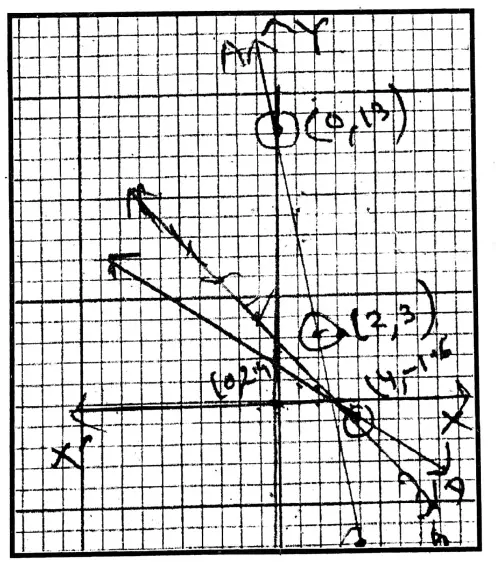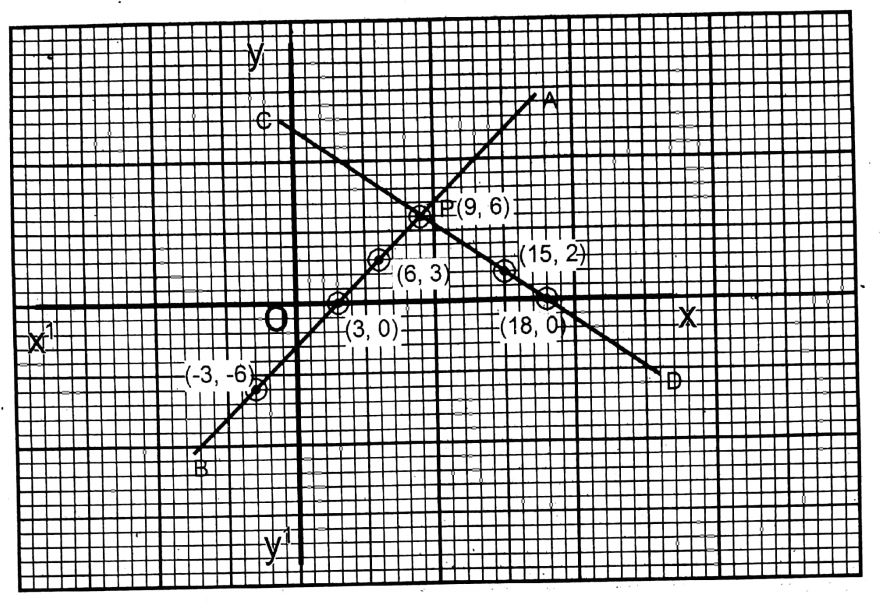Class IX Maths Solutions WBBSE Chapter 5 Linear Simultaneous Equations Exercise 5.7
Question 1. My friend Rita has bought 5 pens and 3 pencils at Rs. 34 from the bookshop nearby our school. But Sumita has bought 7 pens and 6 pencils at Rs. 53 at the same rate and from the same shop. I write by calculating the price of each pen and pencil by framing simultaneous equations.
Solution:
Given
My friend Rita has bought 5 pens and 3 pencils at Rs. 34 from the bookshop nearby our school. But Sumita has bought 7 pens and 6 pencils at Rs. 53 at the same rate and from the same shop.
Let the price of one pen is Rs. x & the price of one pencil is Rs. y.
According to 1st condition,
5x + 3y = 34…(1)
According to 2nd condition,
7x+6y=53…(2)
Multiplying equation (1) by 2 & equation (1) by 1
10x+6y = 68 ….(3)
Ading eq(3)+(2)
Read and Learn More WBBSE Solutions For Class 9 Maths
\(\begin{aligned}
& 10 x+6 y=68 \\
& 7 x+6 y=53
\end{aligned}
\)
Class IX Maths Solutions WBBSE
Adding, 3 x=15
Or, \( x=\frac{15}{3} \)
or, x =5
Putting the value of x in equation (1),
5 x 5+3y=34
or, 25+3y=34
or, 3y=34-25
or, 3y=9
or, y= \( y=\frac{9}{3} \)
or, y = 3
∴ Price of one pen Rs. 5 and one pencil = Rs. 3.
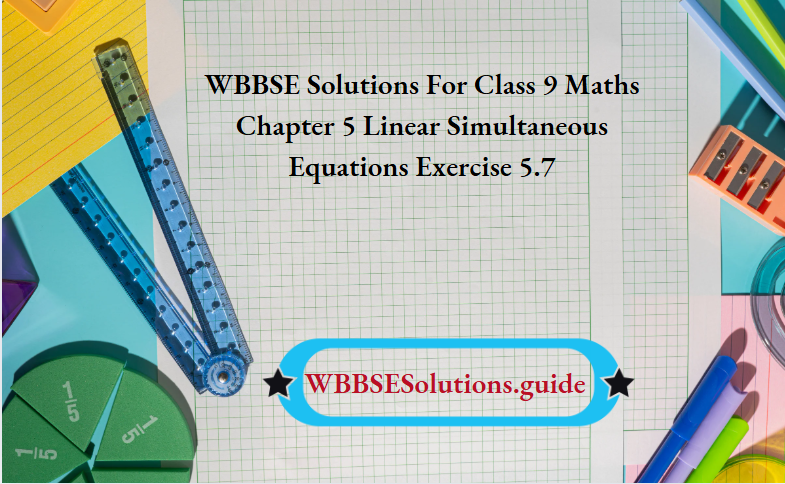
Wbbse Class 9 Maths Chapter 5.7 Linear Simultaneous Equations Solutions
Question 2. The weights of my friend Ayesha and Refique altogether are 85 kg. The half \( \frac{4}{9} \) of weight of Ayesha is equal to the th of weight of Rafique. Let us calculate and write the weights of them separately by forming simultaneous equations.
Solution:
Given
The weights of my friend Ayesha and Refique altogether are 85 kg. The half \( \frac{4}{9} \) of weight of Ayesha is equal to the th of weight of Rafique.
Let the weight of Ayesha = x kg and the
weight of Refique = y kg.
According to 1st condition,
x+y= 85….(1)
According to 2nd condition,
\( \frac{x}{2}=\frac{4 y}{9} \) ….(2)
or, 9x = 8y
or, 9x – 8y = 0…. (3)
Multiplying equation (1) by 8,
8x+8y = 680…. (4)
Adding eq(4)+(3)
8x+8y = 680
8x+8y = 680
We get, 17x= 680
or, \( x=\frac{680}{17} \)
or, x = 40
Putting the value of x in equation (1),
40+ y = 85
or, y = 85-40
or, y = 45
Weight of Ayesha = 40 kg & weight of Refique = 45 kg.
Class IX Maths Solutions WBBSE
Question 3. My uncle’s present age is twice of my sister’s age. 10 years ago, my uncle’s age was thrice of my sister’s age. Let me calculate and write their present age separately by forming simultaneous equations.
Solution:
Given
My uncle’s present age is twice of my sister’s age. 10 years ago, my uncle’s age was thrice of my sister’s age.
Let the pesent age of uncle = x years
and the present age of sister = y years
10 years ago, uncle’s age = (x-10) years &
10 years ago, sister’s age (y-10) years
According to 1st condition,
x = 2y
or, x-2y= 0…. (1)
According to 2nd condition,
(x-10)=3(y-10)
or, x-10=3y-30
or, x-3y=30+ 10
or, x-3y=-20…. (2)
Adding eq (2) + (1) we get
\(\begin{aligned}& x-3 y=-20 \\
& x-2 y=0 \\
& \begin{array}{l}
(-) \quad(+) \quad(-)
\end{array} \\
& \text { Adding, }-y=-20
\end{aligned}\)
Class IX Maths Solutions WBBSE
or, y = 20
Putting the value of x in equation (1),
X- 2×20=0
or, x = 40
Present age of my uncle is 40 years and of my sister is 20 years.
Wbbse Class 9 Linear Simultaneous Equations Exercise 5.7 Solutions
Question 4. Debkumarkaku of our village draws Rs. 590 through a cheque from the bank. If he receives 70 notes in a total of the notes of Rs. 10 and Rs. 5, then let us calculate and write the number of notes of Rs. 10 and Rs. 5.
Solution:
Given
Debkumarkaku of our village draws Rs. 590 through a cheque from the bank. If he receives 70 notes in a total of the notes of Rs. 10 and Rs. 5,
Let the number of Rs. 10 notes = x
and the number of Rs. 5 notes = y.
According to 1st condition,
x + y = 70. ….(1)
According to 2nd condition,
5x + 10y=590….(2)
Multiplying equation (1) by 10,
10x + 10y=700.….(3)
Adding, eq(3) + eq(2)
\(\begin{aligned}
& 10 x+10 y=700 \\
& 5 x+10 y=590 \\
& (-) \quad (-) \quad(-)
\end{aligned}\)
Class 9 Mathematics West Bengal Board
\(Adding, \quad 5 x=110 \)
Or, \( x=\frac{11}{5} \)
or, x = 22
Putting the value of x in equation (1)
22 + y = 70
or, y = 70-22 or, y = 48
∴ Number of Rs. 10 notes = 48
& Number of Rs. 5 notes = 22
Class 9 Wbbse Maths Linear Equations Exercise 5.7 Solved Problems
Question 5. I write a proper fraction in our school blackboard whose denominator is greater than its numerator by 5 and when 3 is added to both the numerator and denominator it becomes 3/4. Let us form the simultaneous equations and by solving write the proper fraction on the blackboard.
Solution:
Given
I write a proper fraction in our school blackboard whose denominator is greater than its numerator by 5 and when 3 is added to both the numerator and denominator it becomes 3/4.
Let the fraction be \( \frac{x}{y} \) where the numerator is x and denominator is y and x < y.
According to 1st condition,
y = x + 5….(1)
According to 2nd condition,
\( \frac{x+3}{y+3}=\frac{3}{4} \) …(2)
Class 9 Mathematics West Bengal Board
or, \( \frac{x+3}{x+5+3}=\frac{3}{4}(because y=x+5) \)
or, \( \frac{x+3}{x+8}=\frac{3}{4} \)
or, 4x+12= 3x + 24
or, 4x-3x=24-12
or, x = 12
Putting the value of x in equation (1)
y=12+5
or, y = 17
Required fraction = \( \frac{12}{17} \)
Question 6. Maria has written two numbers in her exercise copy such that the addition of 21 with the first number gives twice of the second number. A gain, addition of 12 with the second number gives twice of the first number. Let us calculate and write the two numbers Maria has written.
Solution:
Given
Maria has written two numbers in her exercise copy such that the addition of 21 with the first number gives twice of the second number. A gain, addition of 12 with the second number gives twice of the first number.
The two numbers are x &y.
According to 1st condition,
x +21= 2y. …(1)
According to 2nd condition,
or, x = y + 12 …(2)
From equation (1) x=2y-21 …(3)
From equation (2) x = \( \frac{y+12}{2} \)
Comparing two values of x from equations (3) & (4),
2y-21= \( \frac{y+12}{2} \)
or, 4y-42 = y+12
or, 4y -y 12+42
or, 3y = 54
or, y = \( \frac{54}{3} \)
or, y = 18
Putting the value of x in equation (4)
\( x=\frac{18+12}{2} \)Class 9 Mathematics West Bengal Board
Or, \( x=\frac{30}{2} \)
or, x = 15
1st number is 15 & 2nd number is 18.
Wbbse Class 9 Maths Chapter 5.7 Linear Equations Notes
Question 7. Both of Lalima and Romen clean their garden. If Lalima works for 4 days and Romen works for 3 days, then \( \frac{2}{3} \) part of the work is completed. Again, if Lalima works for 3 days and Romen works for 6 days, then \( \frac{11}{12} \) part of the work is completed. Let us form the simultaneous equations and write the number of days required to complete the work separately by Lalima and Romen by calculating the solution.
Solution:
Given
Both of Lalima and Romen clean their garden. If Lalima works for 4 days and Romen works for 3 days, then \( \frac{2}{3} \) part of the work is completed. Again, if Lalima works for 3 days and Romen works for 6 days, then \( \frac{11}{12} \) part of the work is completed.
Let Lalima can do the whole (I) work in x days
and Romen can do the whole work in y days.
According to 1st condition,
\( \frac{4}{x}+\frac{3}{y}=\frac{2}{3} \) …(1)
According to 2nd condition,
\( \frac{3}{x}+\frac{6}{y}=\frac{11}{12} \) ….(2)
Multiplying equation (1) by 2,
\( \frac{8}{x}+\frac{6}{y}=\frac{4}{3} \) …(3)
Class 9 Mathematics West Bengal Board
Adding eq(3)+eq(2)
\( \begin{aligned}& \frac{8}{x}+\frac{6}{y}=\frac{4}{3} \\
& \frac{3}{x}+\frac{6}{y}=\frac{11}{12} \\
& (-)(-)(-)
\end{aligned} \)
We get, \( \frac{8}{x}-\frac{3}{x}=\frac{4}{3}-\frac{11}{12} \)
\( or, \frac{8-3}{x}=\frac{16-11}{12}
or, \frac{5}{x}=\frac{5}{12}
or, \frac{1}{x}=\frac{1}{12} \)
or, x = 12
Putting the value of x in equation (1)
\(\frac{4}{12}+\frac{3}{y}=\frac{2}{3}
or, \frac{1}{3}+\frac{3}{y}=\frac{2}{3}
or, \frac{3}{y}=\frac{2}{3}-\frac{1}{3}
or, \frac{3}{y}=\frac{2-1}{3}
or, \frac{3}{y}=\frac{1}{3}\)
Class 9 Maths WB Board
or, y =9
∴Lalima can do the work in 12 days and Romen can do the work in 9 days.
Question 8. My mother has prepared two types of sherbet. There is 5 kg sugar in 100 litre sherbat of the first type and 8 kg sugar in 100 litre sherbat of the second type. By mixing these two types, I will prepare 150 litre sherbet which contains \( 9 \frac{2}{3} \) kg sugar. Forming simultaneous equations let us calculate how much quantity of the two types of sherbat will be mixed to prepare 150 litre sherbat.
Solution:
Given
My mother has prepared two types of sherbet. There is 5 kg sugar in 100 litre sherbat of the first type and 8 kg sugar in 100 litre sherbat of the second type. By mixing these two types, I will prepare 150 litre sherbet which contains \( 9 \frac{2}{3} \) kg sugar.
Let the quantity of 1st type of sherbet = x liter & the quantity of 2nd type of sherbat = y litre.
According to 1st condition,
x + y = 150 …(1)
According to 2nd condition,
\(\frac{5 x}{100}+\frac{8 y}{100}=9 \frac{2}{3} \)
Or, \( \frac{5 x+8 y}{100}=\frac{29}{3} \)
or, 15x + 24y= 2900 …(2)
Multiplying both sides of equation (1) by 15,
15x+15y = 2250 ….(3)
Adding eq(3) + eq(2)
\( \begin{aligned}& 15 x+15 y=2250 \\
& 15 x+24 y=2900 \\
& (-) \quad(-) \quad(-)
& -9 y=-650
\end{aligned} \)
Class 9 Maths WB Board
We get, -9y = -650
Or, \( y=\frac{-650}{-9} \)
Or, \( y=72 \frac{2}{9} \text { litre } \)
Putting the value x in equation (1)
\( x+\frac{650}{9}=150 \)
Or, \( \text { or, } x=150-\frac{650}{9} \)
Or, \( x=\frac{1350-650}{9} \)
Or, \( x=\frac{700}{9} \)
Or, \( x=77 \frac{7}{9} \) litre.
West Bengal Board Class 9 Linear Simultaneous Equations Exercise 5.7 Solutions
Question 9. Last year Akhilbabu and Chhandadebi were the candidates in Bakultala Gram-Panchayat election. Akhilbabu defeated Chhandadebi by 75 votes. If 20% of the voters who have casted Ahkilbabu would have casted to Chhandadebi, then Chhandadebi could be won by 19 votes. By forming simultaneous equations let us solve and find out how many votes each of them had got.
Solution:
Given
Last year Akhilbabu and Chhandadebi were the candidates in Bakultala Gram-Panchayat election. Akhilbabu defeated Chhandadebi by 75 votes. If 20% of the voters who have casted Ahkilbabu would have casted to Chhandadebi, then Chhandadebi could be won by 19 votes.
Let Akhilbabu got x votes & Chhandadevi got y votes.
20% of Akhilbabu’s vote = \( \frac{x \times 20}{100}=\frac{x}{5} \)
According to 1st condition,
x – y = 75 ….(1)
According to 2nd condition,
\(\left(y+\frac{x}{5}\right)-\left(x-\frac{x}{5}\right)=19
or, \quad y+\frac{x}{5}-x+\frac{x}{5}=19
or, \quad \frac{5 y+x-5 x+x}{5}=19 \)
or, -3x+5y=95 …(2)
3x – 3y = 225 …(3)
Adding eq(3) +eq(2)
\( \begin{array}{r}3 x-3 y=225 \\
-3 x+5 y=95 \\
\quad 2 y=320
\end{array}\)
Class 9 Maths WB Board
Or, \( y=\frac{320}{2} \)
Or, y = 160
Putting the value y in equation (1)
X-160=75
or, x = 75+ 160
or, x = 235
Akhilbabu got 235 votes & Chhandadevi got 160 votes.
Question10. If the length is increased by 2 m and breadth is increased by 3m, then the area of rectangular floor of Rafique is increased by 75 sq.m. But if the length is reduced by 2 m and breadth is increased by 3 m, the area is increased by 15 sq.m. By forming simultaneous linear equations, let us determine the length and breadth of the floor.
Solution:
Given
If the length is increased by 2 m and breadth is increased by 3m, then the area of rectangular floor of Rafique is increased by 75 sq.m. But if the length is reduced by 2 m and breadth is increased by 3 m, the area is increased by 15 sq.m. By forming simultaneous linear equations
Let the length = xm &
breadth = y m
Area = xy sq. m
According to 1st condition,
(x+2) (y+3)= xy + 75
Or, xy + 3x + 2y + 6-xy = 75
or, 3x + 2y = 75-6
or, 3x + 2y = 69 …(1)
According to 2nd condition,
(x-2) (y+3)=xy + 15
Or, xy+3x-2y-6-xy=15
Or, 3x-2y = 15+6
Or, 3x-2y=21 …(2)
Adding eq(2) + (1)
\(\begin{gathered}3 x-2 y=21 \\
3 x+2 y=69 \\
\hline , 6 x=90
\end{gathered} \)
Class 9 Maths WB Board
Or, \( x=\frac{90}{6} \)
Or, x = 15
Putting the value y in equation (1)
3 x 15+ 2y = 69
or, 45+2y=69
or, 2y=69-45
or, 2y = 24
or, \( y=\frac{24}{2} \)
or, y = 12
Length of the floor = 15 m
Breadth of the floor = 12 m
Wbbse Class 9 Linear Equations Exercise 5.7 Important Questions
Question 11. My friend Meri told Ishan, give me \( \frac{1}{3} \) of your money, then I shall have Rs. 200. Ishan told Meri, give me half of your money, I shall have Rs. 200. Forming simultaneous equations let us calculate how much money each of them possesses.
Solution:
Given
My friend Meri told Ishan, give me \( \frac{1}{3} \) of your money, then I shall have Rs. 200. Ishan told Meri, give me half of your money, I shall have Rs. 200.
Let Meri has Rs. x & Inhan has Rs. y.
According to 1st condition,
\( x+\frac{y}{3}=200 \)
Or,\( \frac{3x+y}{3}=200 \)
Or, 3x+y =600 …(1)
According to 2nd condition,
\( \frac{x}{2}+y=200 \)Or,\( \frac{x+2 y}{2}=200 \)
Or, x+2y=400 …(2)
Multiplying equation (1) by 2,
6x + 2y = 1200 ….(3)
Adding eq(3)+(2)
\( \begin{array}{cc}6 x+2 y= & 1200 \\
x+2 y= & 400 \\
(-) \quad(-) & (-)
\end{array} \)
Maths WBBSE Class 9 Solutions
We get, 5x = 800
Or, \( x=\frac{800}{5} \)
or, x = 160
Putting the value y in equation (1)
160+ 2y = 400
or, 2y= 400-160
or, 2y = 240
or, \( y=\frac{240}{2} \)
or, y = 120
∴ Meri has Rs 160 & Ishan has Rs. 120.
Question 12. Today my elder brother and some of his friends will go to a fair. So, grandfather divided some money equally among them. We are observing that if the number of friends is less by 2, then each of them would get Rs. 18. Again, if the number of friends is more by 3, then each of them would get Rs. 12. Let us calculate and write the number of persons went to the fair and how much money grandfather divided among them in total.
Solution:
Given
Today my elder brother and some of his friends will go to a fair. So, grandfather divided some money equally among them. We are observing that if the number of friends is less by 2, then each of them would get Rs. 18. Again, if the number of friends is more by 3, then each of them would get Rs. 12
Let grandfather gives Rs x & number of friends is
According to 1st condition,
\( \frac{x}{y-2}=18 \)
Or, x = 18(y-2) …..(1)
According to 2nd condition,
\( \frac{x}{y+3}=12 \) …(2)
Maths WBBSE Class 9 Solutions
Comparing the values of x in equation (1) & equation (2),
18(y – 2) = 12 (y+3)
or, 18y – 36 = 12y +36
or, 18y – 12y= 36+36
or, 6y=72
or, \( y=\frac{72}{6} \)
or, y = 12
Putting the value y in equation (2)
x = 12 (12+3)
or, x = 12 x 15
or, x = 180
No. of rupees = Rs 180. No. of friends = 15.
Wbbse Class 9 Maths Linear Equations Exercise 5.7
Question 13. In my elder brother’s bag there are Rs. 350 with the coins of Rs. 1 and 50 paise together. My sister has put out \( \frac{1}{3} \) part of 50 paise coins from the bag and in its place she has put into the bag equal number of coins of Rs. 1 and now the total amount of money in the bag is Rs. 400. Let us calculate and write the original number of coins of Rs. 1 and 50 paise kept at first separately in my brother’s bag.
Solution:
Given
In my elder brother’s bag there are Rs. 350 with the coins of Rs. 1 and 50 paise together. My sister has put out \( \frac{1}{3} \) part of 50 paise coins from the bag and in its place she has put into the bag equal number of coins of Rs. 1 and now the total amount of money in the bag is Rs. 400.
Let no. of Re. 1 coin = x; no. of 50p coin = y.
According to 1st condition,
\(x+\frac{y}{2}=350or, \quad \frac{2 x+y}{2}=350 \)
or, 2x + y = 700 …(1)
According to 2nd condition,
\( \left(y-\frac{y}{3}\right) \times \frac{1}{2}+\left(x+\frac{y}{3}\right) \times 1=400 \)Maths WBBSE Class 9 Solutions
Or, \( \frac{y}{2}-\frac{y}{6}+x+\frac{y}{3}=400 \)
Or, \( \frac{3 y-y+6 x+2 y}{6}=400 \)
Or,6x + 4y = 2400
or, 3x + 2y = 1200 …(2)
Multiplying equation (1) by 2,
4x + 2y = 1400 …(3)
\( \begin{aligned}& 4 x+2 y=1400 \\
& 3 x+2 y=1200 \\
& (-) \quad(-) \quad(-)
\end{aligned} \)
Putting the value of x in equation (1) x = 200
Putting the value y in equation (2)
2 x 200 + y = 700
or, y = 700 – 400
or, y = 300
No. of Re. 1 coin 200 & 50p coin = 300.
Question 14. Today, we will go to my maternal uncle’s house, so a motor car sets out from our house towards my maternal uncle’s house at a uniform speed. If the speed of the car would be increased by 9 km/hr then the time required to cover this path would be less by 3 hours. Again, if the speed would be decreased by 6 km hr, then 3 hours more time would be required to cover this path. Let us calculate and write the distance between our house and my maternal uncle’s house and the speed of the car.
Solution:
Given
Today, we will go to my maternal uncle’s house, so a motor car sets out from our house towards my maternal uncle’s house at a uniform speed. If the speed of the car would be increased by 9 km/hr then the time required to cover this path would be less by 3 hours. Again, if the speed would be decreased by 6 km hr, then 3 hours more time would be required to cover this path.
Let the distance = x km & speed of car = y km/hr.
According to 1st condition,
\( \frac{x}{y+9}=\frac{x}{y}-3 \) ….(1)
According to 2nd condition,
\( \frac{x}{y-6}=\frac{x}{y}+3 \) ….(2)
Maths WBBSE Class 9 Solutions
From equation (2) \( \frac{x}{y+9}-\frac{x}{y}= 3\)
Or, \( x\left(\frac{1}{y+9}-\frac{1}{y}\right)=-3 \)
Or, \( x\left(\frac{y-y-9}{y(y+9)}\right)=-3 \)
Or, \( \frac{-9 x}{y(y+9)}=-3 \)
or, \( \frac{3 x}{y(y+9)}=1 \)
Or, \( x=\frac{y(y+9)}{3} \) …(3)
From equation (1) \( \frac{x}{y-6}-\frac{x}{y}=3 \)
Or, \( x\left(\frac{1}{y-6}-\frac{1}{y}\right)=3 \)
Or, \( x\left(\frac{y-y+6}{y(y-6)}\right)=3 \)
or, \( \frac{6 x}{y(y-6)}=3 \)
Or, \( \frac{2 x}{y(y-6)}=1 \)
Or, \( x=\frac{y(y-6)}{2} \) ….(4)
Comparing the values of x from equations (3) & (4),
\( \frac{y(y+9)}{3}=\frac{y(y-6)}{2} \)
Or, \( \frac{y+9}{3}=\frac{y-6}{2} \)
or, 3y 18 2y + 18
or, 3y-2y= 18+ 18
or, y = 36
Putting the value y in equation (3)
Or, \( x=\frac{36(36+9)}{3} \)
or, x = 12 x 45
or, x = 540
∴ Distance = 540 km & speed of the car = 36 km/hr.
Question 15. Mohit will write such a two digit number that 4 times of the sum total of he two digits will be 3 more of the number; and if the digits are reversed, the number will be increased by 18. Let us calculate the number which Mohit would write.
Solution:
Given
Mohit will write such a two digit number that 4 times of the sum total of he two digits will be 3 more of the number; and if the digits are reversed, the number will be increased by 18.
Let two digit no. = 10x + y.
According to 1st condition,
10x + y = 4(x + y) +3
or, 10x + y -4x-4y = 3
or,6x-3y=3
or,2x – y = 1 …(1)
According to 2nd condition,
10y + x = 10x + y + 18
Or, 10y+x-10x-y=18
Or, – 9x+9y= 18
Or, -9(x – y)- 18
Or, \( x-y=\frac{18}{-9} \)
X – y= -2 …(2)
Adding eq(2)+(1)
\(\begin{aligned}& x-y=-2 \\
& 2 x-y=1 \\
& (-)(+)(-)
\end{aligned} \)
Maths WBBSE Class 9 Solutions
We get, -x = -3
Or, x =3
Putting the value y in equation (1)
2 x 3-y=1
or,-y = 1-6
or, – y = -5
or, y = 5
Required Number
= 10x + 3
= 10 x 3 +5
= 30+ 5
= 35
Wbbse 9th Class Maths Linear Simultaneous Equations Step By Step Solutions Exercise 5.7
Question 16. I shall write a two digit number, the sum of two digits of which is 14 and if 29 is subtracted from the number, the two digits will be equal. Let us form simultaneous equations and by solving them let us see what will be the two digit number.
Solution:
Given
I shall write a two digit number, the sum of two digits of which is 14 and if 29 is subtracted from the number, the two digits will be equal.
Let the two digit number be 10x + y whose tenths digit is x and units digit y.
According to 1st condition,
x + y = 14 …(1)
After subtracting 29 from the number we get, the new number is = 10x + y – 29
or, 10x+y30+1
or, 10x-30+ y + 1
or, 10(x-3)+(y+1)
According to 2nd condition,
or, x-3= y + 1
or, x-y=1+3
or, x-y= 4 …(2)
Adding eq (2) + (1)
\(\begin{array}{r}
x-y=4 \\
x+y=14 \\
\hline 2 x=18
\end{array} \)
Or, \(x=\frac{18}{2}\)
Or, x =9
Putting the value y in equation (1)
9+y=14
or, y = 14-9
or, y=5
Required Number
= 10x + y
= 10 x 9 +5
= 90 + 5
= 95
Class 9 Maths WB Board
Question 17. Rahamat chacha covers 30 miles in 6 hours in downstream and returns the same distance in 10 hours in upstream by his boat. Let us calculate and write the speed of Rahamat chacha’s both in still water and the speed of the stream too.
Solution:
Given
Rahamat chacha covers 30 miles in 6 hours in downstream and returns the same distance in 10 hours in upstream by his boat.
Let speed of boat = x mile / hr speed of stream = y mile/hr.
∴ Speed of boat in downstream = (x + y) mile/hr
∴ Speed of boat in upstream = (x − y) mile/hr
According to 1st condition,
6(x + y) = 30
Or, \( x+y=\frac{30}{6} \)
Or, x + y = 5 …(1)
According to 2nd condition,
10(x-y) = 30
Or, \( x-y=\frac{30}{10} \)
Or, x – y = 3 ….(2)
Adding eq(2) + eq(1)
\(\begin{aligned}& x-y=3 \\
& {x+y}=5 \\
& \hline 9,2 x=8
\end{aligned}\)
Or, \( x=\frac{8}{2} \)
Or, x = 4
Putting the value y in equation (1)
4+y=5
or, y 5-4
or, y = 1
Speed of boat = 4 mile/hr
Speed of stream = 1 mile/hr.
Wbbse Class 9 Maths Methods To Solve Linear Simultaneous Equations Exercise 5.7
Question 18. Leaving Howrah station after 1 hour a train is late by 1 hour for special \( \frac{3}{5} \) reason and then running with th of its initial speed it reaches its destination after 3 hours. If the special reason would be 50 km, away from its first place, then Ithe train would reach its destination 1 hour 20 minutes before its previous time. Let us calculate the distance that the train had covered and the original speed of the train.
Solution:
Given
Leaving Howrah station after 1 hour a train is late by 1 hour for special \( \frac{3}{5} \) reason and then running with th of its initial speed it reaches its destination after 3 hours. If the special reason would be 50 km, away from its first place, then Ithe train would reach its destination 1 hour 20 minutes before its previous time.
Let speed of the train be x km/hr & the time = y hr.
Distance = speed x time= x x y km = xy km
According to 1st condition,
\( \frac{x y-x}{\frac{3 x}{5}}+1+1=y+3 \) …(1)
According to 2nd condition,
\(\frac{x+50}{x}+1+\frac{x y-(x+50)}{\frac{3 x}{5}}=y+3-\frac{4}{3}\) …(2)
From equation (1) \(\frac{x y-x}{\frac{3 x}{5}}+1+1=y+3\)
\(or,\frac{5(x y-x)}{3 x}+2=y+3or, \frac{5(y-1)}{3}+2=y+3 \)
or, 5y-5+6=3y+9
or, 5y-3y=9+5-6
or, 2y = 8
or, \( y=\frac{8}{2} \)
or, y = 4
Putting the value y in equation (2)
Or, \( \frac{x+50}{x}+1+\frac{x \times 4-x-50}{\frac{3 x}{5}}=4+3-\frac{4}{3} \)
or, \( \frac{x+50}{x}+\frac{5(4 x-x-50)}{3 x}=7-\frac{4}{3}-1 \)
or, \( \frac{3 x+150+15 x-250}{3 x}=\frac{14}{3} \)
or, \( 18 x-100=\frac{14}{3} \times 3 x \)
or, 18x-100 = 14x
or, 18x-14x= 100
or, 4x = 100
or, \( =\frac{100}{4}\)
or, x = 25 of the train 25 km/hr
Distance = 25 x 4 km = 100 km
Class 9 Maths WB Board
Question 19. Mousumi divides a two digit number with the sum of its digits and gets quotient as 6 and remainder as 6. But if she divides the number interchanging the digits with the sum of its digits, she will get quotient as 4 and remainder as 9. Let us determine the number that Mousumi has taken by forming simultaneous equations.
Solution:
Given
Mousumi divides a two digit number with the sum of its digits and gets quotient as 6 and remainder as 6. But if she divides the number interchanging the digits with the sum of its digits, she will get quotient as 4 and remainder as 9.
Let the two digit number = 10x + y.
According to 1st condition,
10x+y=6(x + y) +6
or, 10x+y=6x+6y+ 6
or, 10x+y-6x-6y= 6
or, 4x-5y = 6 …(1)
According to 2nd condition,
10y + x = 4(x + y) +9
Or, 10y+x-4x-4y=9
or, -3x+6y=9
or,-3(x-2)= 9
or, \( x-2 y=\frac{9}{-3} \)
or, x-2y= 3
or, x = 2y-3
Putting the value y in equation (1)
4(2y3)5y=6
or, 8y 12-5y=6
or, 3y=6+12
or, \( y=\frac{18}{3}\)
or, y = 6
Putting the value y in equation (2)
x=2×6-3
or, x = 12-3
or, x = 9
Required Number
=10x + y
=10 x 9 +6
= 90 +6
= 96
Question 20. When Faridabibi put oranges in some boxes, she observed that if she would put 20 oranges more in each box, then 3 boxes less would be required. But if she would put 5 oranges less in each box, 1 more box would be required. Forming simultaneous equations, let us calculate how many boxes and oranges Faridabibi had.
Solution:
Given
When Faridabibi put oranges in some boxes, she observed that if she would put 20 oranges more in each box, then 3 boxes less would be required. But if she would put 5 oranges less in each box, 1 more box would be required.
Let the number of boxes = y & no of oranges in each box = x.
No of oranges = xy
According to 1st condition,
(x+20) (y-3)=xy
Or, xy-3x+20y-60-xy = 0
or,-3x+20y=60 ….(1)
According to 2nd condition,
(x-5) (y+1)=xy
or, xy+x-5y-5-xy = 0
or, x-5y=5 …(2)
Multiplying the equation (2) by 3
3 x-15 y=15 …(3)
Adding eq(3) + (1)
3 x-15 y=15
-3 x+20 y=60
we get, 5y = 75
Or, \( y=\frac{75}{5} \)
Or, y = 15
Putting the value y in equation (2)
X-5 x 15 = 5
or, x = 5 + 75
or, x = 80
No. of oranges = 80 x 15 = 1200
No. of boxes = 15
Question 21. Short answer type questions
1. If x = 3t and \( y=\frac{2 t}{3}-1 \) then find for what value of t, x = 3y.
Solution: x = 3y
or, \( 3 t=3\left(\frac{2 t}{3}-1\right) \)
or, \( t=\frac{2 t-3}{3} \)
or, 3t = 2t 3
or, 3t-2t=-3
or, t=-3
t=-3 when x = 3y
2. For what value of k, the two equations 2x+5y= 8 and 2x-ky-3 will have no solutions?
Solution: 2x+5y=8, 2x-ky = 3
\( \frac{2}{2}=\frac{5}{-k}\left[therefore \frac{a_1}{a_2}=\frac{b_i}{b_2} \neq \frac{c_1}{c_2}\right] \)Maths WBBSE Class 9 Solutions
Or, \( \frac{1}{1}=\frac{5}{-k} \)
or, – k = 5
k = -5
3. If x, y are real numbers and (x-5)2 + (x-y)2 = 0, then what are the values of x and y?
Solution: (x-5)2 + (x − y)2 = 0
Now, x-5= 0 and x – y = 0
x = 5 and x = y
x=y=5
x=5, y=5
4. If x2 + y2-2x+4y=-5, then what are the values of x and y?
Solution: x2+ y2-2x + 4y = -5
or, x2+y2-2x+4y+5=0
or, x2 – 2x + 1+ y2+4y+4=0
or, (x-1)2+(y+2)2=0
Now, x-1= 0 and y + 2 = 0
x= 1 and y=-2
x=1,y=-2
5. For what value of r, the two equations rx-3y-1 = 0 and (4-r) x – y + 1 = 0 would have no solution?
Solution:
\( \begin{aligned}&\frac{r}{4-r}=\frac{-3}{-1}\\
&\left(because \frac{a_1}{a_2}=\frac{D_1}{b_2} \neq \frac{c_1}{c_2}\right)
\end{aligned} \)
Or, \( \frac{r}{4-r}=\frac{3}{1} \)
or, r = 12-3r
or, r+ 3r = 12
or, 4r = 12
or, \( r=\frac{12}{4} \)
or, r = 3
If r = 3 the equations. have no solution.
6. Let us write the equation a1x+b1y+c1 = 0 in the form of y = mx + c where m & c are constants.
Solution: a1x+b1y+c1 = 0
Or, b1y=-a1x-c1
or, \( y=-\frac{a_1}{b_1} x-\frac{c_1}{b_1} \)
or, y = mx + c
where \( \frac{-a_1}{b_1} \text { and } c=\frac{-c_1}{b_1} \)
7. For what value of k, the two equations kx – 21y+ 15 = 0 and 8x – 7y = O have only one solution?
Solution: If \( \frac{a_1}{a_2} \neq \frac{b_1}{b_2} \) the equations will be solvable and have only one solution.
\( \frac{a_1}{a_2} \neq \frac{b_1}{b_2} \)
Or, \( \frac{k}{8} \neq \frac{-21}{-7} \)
Or, k≠24
Class 9 Wbbse Linear Equations Chapter 5.7 Solved Exercises
8. For what values of a and b, the two equations 5x+8y = 7 and (a+b)x+(a – b)y = (2a+b+1) have infinite number of solutions ?
Solution: If \( \frac{a_1}{b_1}=\frac{b_1}{b_2}=\frac{c_1}{c_2} \text { and } c_1 \neq 0, c_2 \neq 0 \) then the equations will have infinite number of solutions.
From the condition \( \frac{a_1}{a_2}=\frac{b_1}{b_2} \text { we get, } \frac{5}{a+b}=\frac{8}{a-b} \)
Or, 8a+ 8b = 5a-5b
Or, 8a-5b =-5b-8b
Or, 3a = -13b
\( a=\frac{-13 b}{3} \) …(1)
Maths WBBSE Class 9 Solutions
Again, from the relation \( \frac{b_1}{b_2}=\frac{c_1}{c_2} \text { we get, } \frac{8}{a-b}=\frac{7}{2 a+b+1} \)
Or, 16a + 8b+ 8 = 7a -7b
or, 16a-7a+8b+7b+8=0
or, 9a+15b+8=0
or, \( 9\left(\frac{-13 b}{3}\right)+15 b+8=0 \quad\left(because a=\frac{-13 b}{3}\right) \)
or,- 39b + 15b+8=0
or, -24b=-8
\( \begin{aligned}& b=\frac{-8}{-24} \\
& b=\frac{1}{3}
\end{aligned} \)
Putting the value of b in equation
or, \( a=\frac{-13}{3} \cdot \frac{1}{3} \)
or, \( a=\frac{-13}{9} \)
∴ Required value, \( a=\frac{-13}{9}, b=\frac{1}{3} \)
Question 22. Multiple choice questions
1. The two equations 4x + 3y = 7 and 7x-3y = 4 have
1. Only one solution
2. Infinite number of solutions
3. No solution
4. None of them
Solution: If \( \frac{a_1}{a_2} \neq \frac{b_1}{b_2} \) then two equations have only one solutions
Here, \( \frac{3}{6}=\frac{6}{12}=\frac{15}{30} \)
∴ 2. Infinite number of solutions
2. The two equations 3x+6y= 15 and 6x + 12y = 30 have
1. Only one solution
2. Infinite number of solutions.
3. No solution
4. None of them
∴ 2. Infinite number of solutions.
3. The two equations 4x + 4y = 20 and 5x+5y = 30 have
1. Only one solution
2. Infinite number of solutions.
3. No solution
4. None of them
Solution: If \( \frac{a_1}{a_2}=\frac{b_1}{b_2} \neq \frac{c_1}{c_2} \& \quad c_1 \neq 0, c_2 \neq 0 \) then the equations have infinite
4x + 4y = 20 or, x+ y = 5
5x+5y= 30 or, x + y = 6
\( \frac{1}{1}=\frac{1}{1} \neq \frac{5}{6} \)Class 9 Maths WB Board
∴ 3. No solution
4. Which one of the following equations has the solution (1, 1)?
1. 2x + 3y = 9
2. 6x + 2y = 9
3. 3x + 2y = 5
4. 4x+6y= 8
Solution:
1. 2x + 3y = 2×1+3×1=5
2. 6x + 2y = 6×1+2×1=8
3. 3x+2y= 3×1+2×1 = 5
4. 4x+6y=4×1+6×1 = 10
∴ 3. 3x + 2y = 5
5. The two equations 4x + 3y = 25 and 5x-2y= 14 have the solutions.
1. x = 4, y = 3
2. x = 3, y=4
3. x = 3, y=3
4. x = 4, y = -3
Solution:
4x + 3y = 25 …(1)
5x-2y= 14 …(2)
Multiplying equation (1) by 2 & equation (2) by 3,
Adding,
\(\begin{aligned}& 8 x+6 y=50 \\
& 15 x-6 y=42 \\
& \hline 23 x=92
\end{aligned} \)
Or, \( x=\frac{92}{23}=4 \)
Putting the value x in equation (1)
4×4 + 3y = 25
or, 3y=25-16
or, 3y=9
or, \( x=\frac{92}{23}=4 \)
6. The solutions of the equation x + y = 7 are
1. (1, 6), (3,-4)
2. (1, -6), (4, 3)
3. (1, 6), (4, 3)
4. (-1, 6), (-4, 3)
Solution: (1,6), (4,3) satisfy the equation
3. ( 1, 6), (4, 3)

